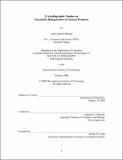| dc.contributor.advisor | Catherine L. Drennan. | en_US |
| dc.contributor.author | Blasiak, Leah Cameron | en_US |
| dc.contributor.other | Massachusetts Institute of Technology. Dept. of Chemistry. | en_US |
| dc.date.accessioned | 2008-11-07T14:09:50Z | |
| dc.date.available | 2008-11-07T14:09:50Z | |
| dc.date.copyright | 2008 | en_US |
| dc.date.issued | 2008 | en_US |
| dc.identifier.uri | http://hdl.handle.net/1721.1/42914 | |
| dc.description | Thesis (Ph. D.)--Massachusetts Institute of Technology, Dept. of Chemistry, 2008. | en_US |
| dc.description | This electronic version was submitted by the student author. The certified thesis is available in the Institute Archives and Special Collections. | en_US |
| dc.description | Vita. | en_US |
| dc.description | Includes bibliographical references. | en_US |
| dc.description.abstract | Halogenated natural products are common and serve roles as hormones, pesticides, antibiotics, and anti-tumor agents. The incorporation of a halogen atom into an organic scaffold can tune the molecule's potency and selectivity, making halogenation an important tailoring reaction. To understand the mechanisms of enzymatic halogenation of natural products, X-ray crystallography was used to solve structures of enzymes from two classes of halogenases, the flavin-dependent halogenases and the non-heme iron dependent halogenases. Structures of the flavin-dependent tryptophan 7-halogenase RebH from Lechevalieria aerocolonigenes, involved in rebeccamycin biosynthesis, were solved by molecular replacement. These structures show distant flavin and L-Trp binding sites and identify the conserved residue Lys79 as a likely candidate for covalent modification to produce an enzyme-bound lysine chloramine intermediate. A lysine chloramine at this position would direct the chlorination reaction to the correct site on the substrate, which could account for the halogenase's observed regioselectivity. Crystal structures of the non-heme iron-dependent threonine 4-halogenase SyrB2 from Pseudomonas syringae, involved in syringomycin biosynthesis, were solved using selenomethionine labeling and single wavelength anomalous dispersion (SAD) techniques. These structures show an overall cupin or [beta]-sandwich fold and a novel iron binding motif containing a naturally occurring iron-chloride bond. The carboxylate ligand typically found in non-heme iron dependent hydroxylases is replaced by an alanine residue in the halogenases, opening a coordination site for the halide and suggesting a mechanism by which these enzymes accomplish halogenation instead of hydroxylation. | en_US |
| dc.description.abstract | (cont)The final chapter of this thesis reviews the known classes of halogenating enzymes and examines questions of halide binding and selectivity from the perspective of protein structure. | en_US |
| dc.description.statementofresponsibility | by Leah Cameron Blasiak. | en_US |
| dc.format.extent | 234 p. | en_US |
| dc.language.iso | eng | en_US |
| dc.publisher | Massachusetts Institute of Technology | en_US |
| dc.rights | M.I.T. theses are protected by
copyright. They may be viewed from this source for any purpose, but
reproduction or distribution in any format is prohibited without written
permission. See provided URL for inquiries about permission. | en_US |
| dc.rights.uri | http://dspace.mit.edu/handle/1721.1/7582 | en_US |
| dc.subject | Chemistry. | en_US |
| dc.title | Crystallographic studies on enzymatic halogenation of natural products | en_US |
| dc.type | Thesis | en_US |
| dc.description.degree | Ph.D. | en_US |
| dc.contributor.department | Massachusetts Institute of Technology. Department of Chemistry | |
| dc.identifier.oclc | 244391459 | en_US |
